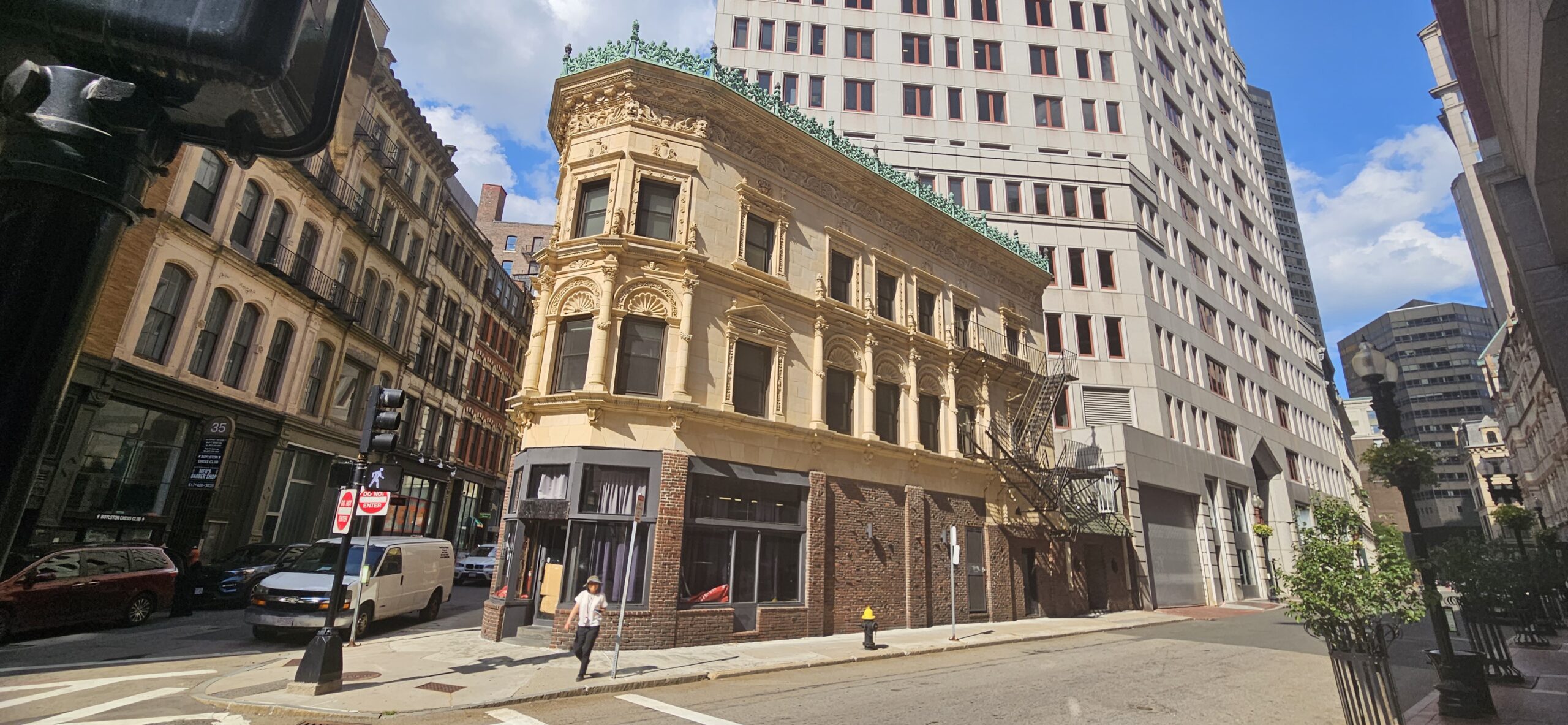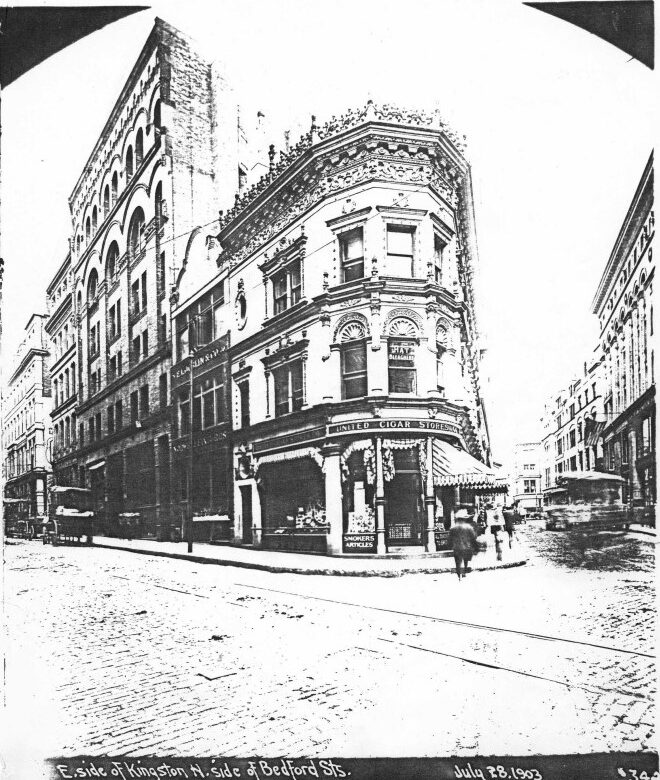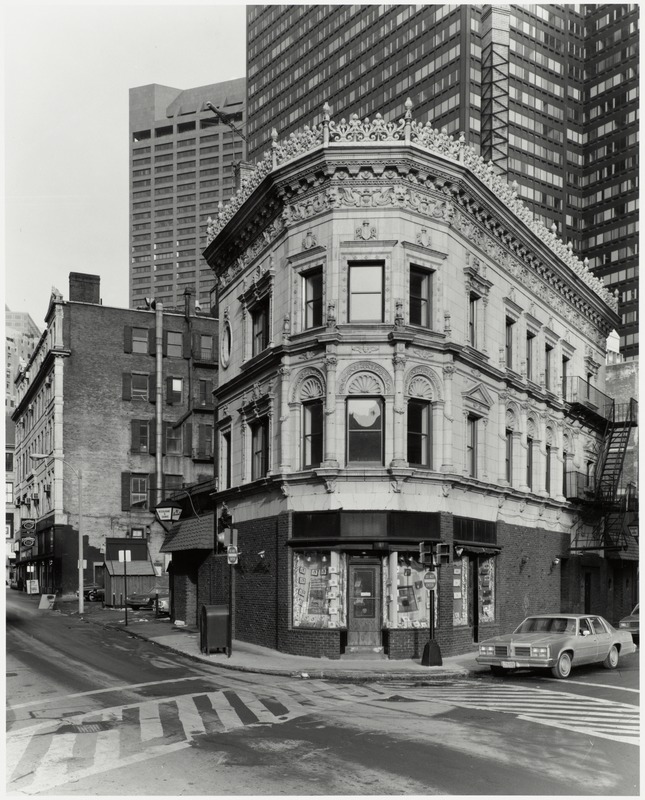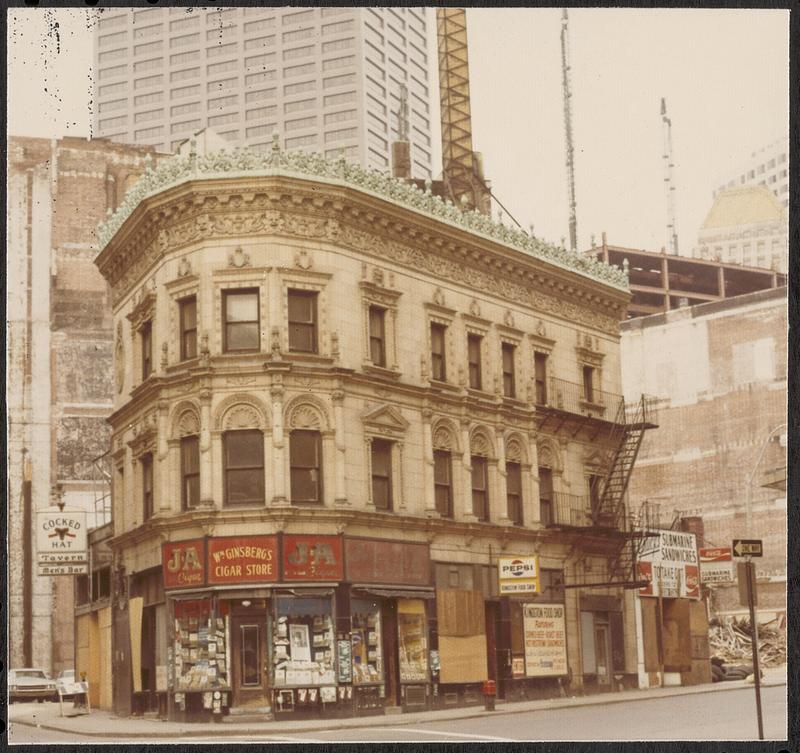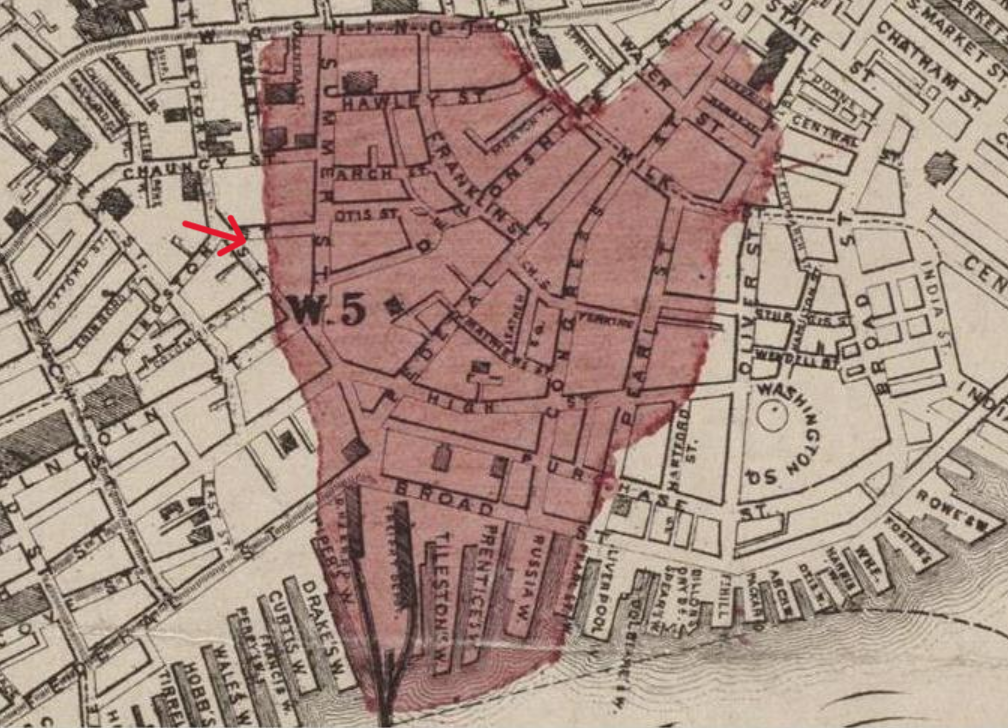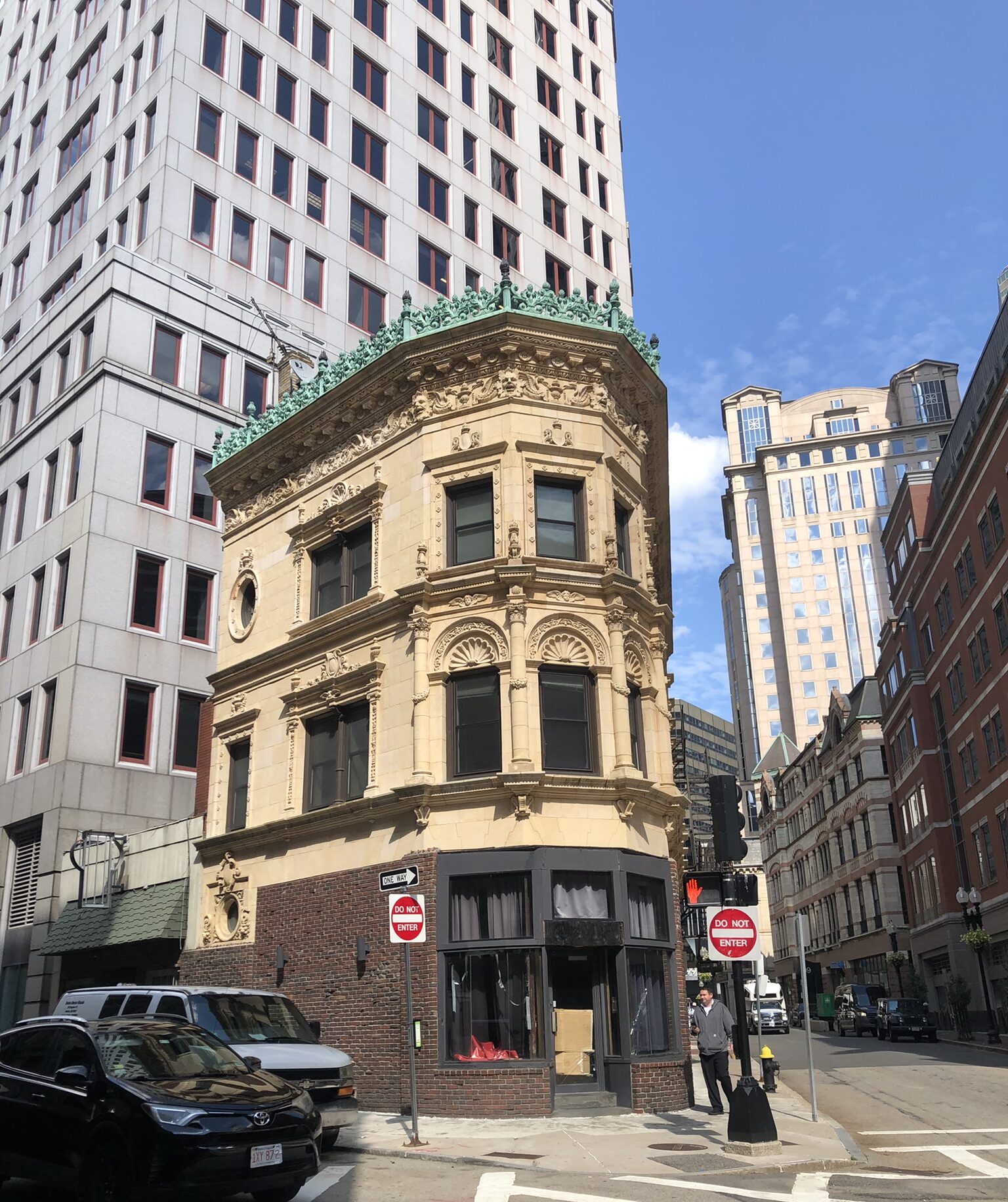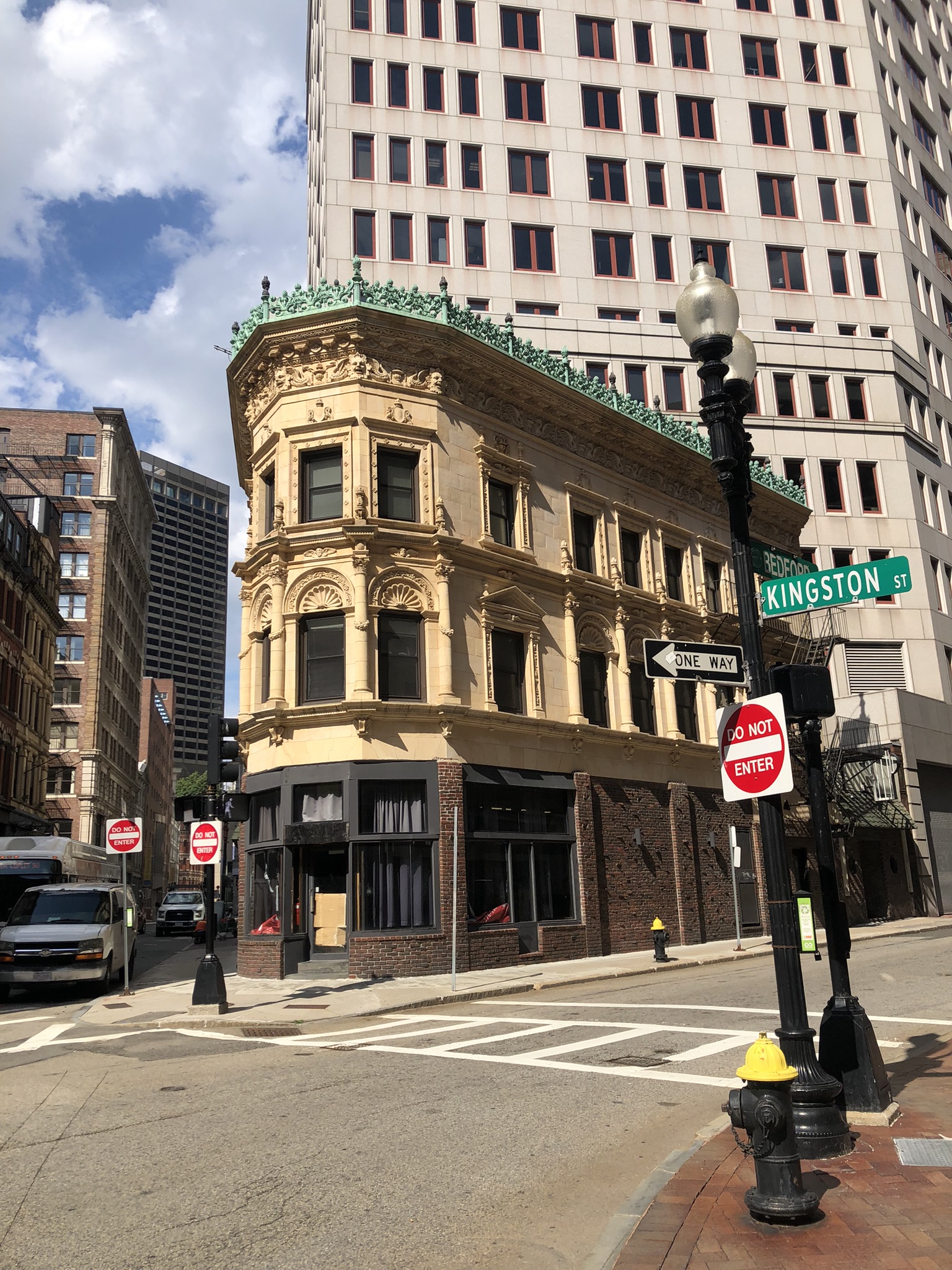
August 26, 2024 The Proctor Building: “A dazzling display of 19th century architectural terra cotta”
Last month, Historic Boston was invited to tour a gorgeous Spanish Renaissance-inspired building in what is known as Boston’s Commercial Palace National Register Historic District. Located at 100 Bedford Street, the Proctor Building, a tiny triangular terra cotta commercial building, continues to steal breaths away as passersby stumble upon this “piece of urban jewelry” amid a tangle of concrete and sky-scrapers.
Constructed in 1897, the Proctor Building is a rare example of the lost craft of terra cotta as a building material, considering the extent of the small building’s architectural ornamentation. The building was named for Thomas E. Proctor (1834-1894), a successful leather merchant whose estate oversaw the construction of the building after his death in 1894. The Proctor Building was an ode to its namesake: a monument molded in terra cotta to a behemoth of the New England leather industry, in what had once been Boston’s Leather District.
Interestingly, the Proctor family’s roots extend far beyond New England’s leather industry. According to a family history compiled by Leland Proctor in 1985, Thomas E. Proctor’s ancestors were victims of the 1692 Salem Witch Trials. John and Elizabeth Proctor were accused of witchcraft, and John was hanged on what became known as Proctor’s Ledge on Gallows Hill in Salem. His wife, Elizabeth, was granted a temporary reprieve because she was pregnant, escaping the gallows when a new governor ended the witch hunt. The tragic case of John and Elizabeth Proctor was to be the inspiration for Arthur Miller’s famous play The Crucible.
Jump forward several generations, and in 1849 at the age of 15, Thomas Proctor went to work in his father’s leather tannery in Peabody. By 1862, he took over management of the Proctor Tannery, which specialized in making leather soles for shoes, making a fortune off of the sale of leather to the Union Army throughout the Civil War. Proctor restructured his business under the name Thomas E. Proctor Leather Company in 1887. He went on to merge his leather business with those of others, forming the United States Leather Company in 1893. The trustees of his estate purchased the triangular parcel in 1896 from the New England Shoe and Leather Association.
The architectural firm that designed the Proctor Building was Walter T. Winslow, George H. Wetherell, and Henry F. Bigelow. They were likely inspired by the 1893 book entitled Renaissance Architecture and Ornamentation in Spain by Andrew N. Prentice, with intricate designs depicting the Alcazar at Toledo, the University of Alcala de Henares, and the Monastery of Poblet identified as inspiration for elements of the Proctor Building.
The elaborate yellow terra-cotta façade remains intact in the upper stories, whereas the ground-floor and storefront is now brick, likely having been destroyed in attempts at modernization. A 1936 permit to allow an alteration to “bring out sash even with the sidewalk,” may have been when the storefront was demolished and bricked up. The second story windows are capped with scalloped fan arches, and flanked by ionic pilasters. Above the second floor is a frieze with the heads of winged putti or cherubs and shells. The cornice has metopes, egg-and-dart molding and dentils, and is surmounted by high copper torch cresting. The craftsmanship and Spanish Renaissance style of the Proctor Building, whose ornamentation is very unusual for a commercial structure, gives the building unique significance in Boston’s architectural landscape.
The building also stands as the representative culmination of decades of technical advancement in the craft of terra cotta architecture, which would unfortunately become obsolete after concrete and metal cladding became the standard building materials of the 1920s and 30s. Prior to the building’s construction, this area of Boston had experienced several devastating fires, the most damaging of which was the Great Fire of 1872. In the map of destruction wrought by the 1872 fire below, the Proctor Building parcel is identified with a red arrow, just outside the zone of catastrophe. The Boston Landmarks report on the Proctor Building notes that the building formerly onsite had been destroyed by fire, so perhaps that building had burnt, along with so many others, in the Great Fire of 1872. For this, architects for the Proctor Building likely chose terra cotta for its fireproof qualities, the potential it held for cost-effective architectural ornamentation being a spectacular added bonus.
In 1903, the ground floor was leased to the United Cigar Stores Company, which opened eleven other locations in Boston that year, one of which was in HBI’s flagship building: the Old Corner Bookstore. Throughout the 20th century, the Proctor Building storefront was occupied by several other cigar/ tobacco companies then primarily by luncheonettes and restaurants in the last quarter of the century. The ground floor and basement had been occupied by Good Life, a restaurant with a nightclub from 2005-2022. The upper floors have been converted into two apartments.
We don’t yet know what the future holds for the Proctor Building, but the possibilities for what a 1983 Boston Globe review termed a “piece of urban jewelry,” are near endless. Keep up with HBI’s newsletter or follow us on Facebook, Linkedin, or Instagram for updates.
Sources:
“Bos. 1558.” Boston Landmarks Commission Report, June 1980. Massachusetts Historical Commission. Accessed August 7, 2024. https://mhc-macris.net/details?mhcid=bos.1558
“Close-up Map of Boston and the Burnt District, 1872.” Boston Fire Historical Society. Accessed August 22, 2024. https://bostonfirehistory.org/fires/great-boston-fire-of-1872/
Bruce Bolnick. “Thomas Proctor’s Wealth.” Topsfield, MA. January 2017. https://topsfieldhistory.org/collections/files/original/d8398a239420b7848cd95c7f33b51195.pdf
Boston Landmarks Commission. “Report of the Boston Landmarks Commission on the Potential Designation of THE PROCTOR BUILDING as a Landmark under Chapter 772 of the Acts of 1975, as Amended July 1, 1983.” https://www.boston.gov/sites/default/files/embed/p/proctor-building-study-report.pdf




